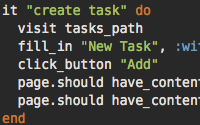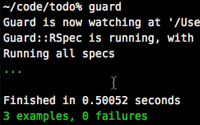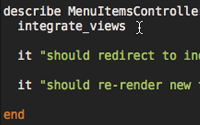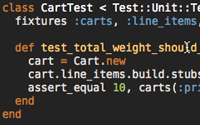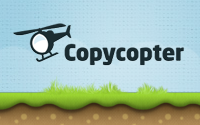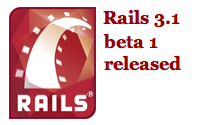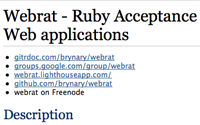Types
- Free Episodes
- Pro Episodes
- Revised Episodes
Categories
- Active Record
- Active Resource
- Active Support
- Administration
- Ajax
- APIs
- Authentication
- Authorization
- Background Jobs
- Caching
- Code Walkthrough
- Controllers
- Debugging
- Deployment
- eCommerce
- Forms
- Mailing
- Models
- Performance
- Plugins
- Production
- Rack
- Rails 2.0
- Rails 2.1
- Rails 2.2
- Rails 2.3
- Rails 3.0
- Rails 3.1
- Rails 3.2
- Rails 4.0
- Refactoring
- Routing
- Search
- Security
- Testing
- Tools
- Views
Request Specs and Capybara
Request specs in RSpec are a great way to ensure the entire application stack is working properly. Here I also show how to use capybara with integrated JavaScript testing using Selenium.
(13 minutes)
Exploring RubyGems
RubyGems can make it easy to add a feature to a Rails application, but it can also cause headaches down the road. Here I give some tips on researching gems to decide which one to choose, or when to do it from scratch.
(7 minutes)
Guard
Guard watches files and runs a command after a file is modified. This allows you to automatically run tests in the background, restart your development server, reload the browser, and more.
(8 minutes)
Testing Controllers with RSpec
Controllers are tricky to test, and there's no perfect way to do it. In this episode you will see how I test controllers, and my reasoning behind it.
(11 minutes)
Testing without Fixtures
Tests which rely heavily on fixtures are brittle and can be difficult to maintain. This episode will show a couple techniques for creating tests which don't use fixtures.
(9 minutes)
Copycopter
Copycopter provides a nice interface that clients can use to edit the text in a Rails application. Learn how to deploy a Copycopter server using Heroku and integrate it in a Rails application through I18n.
(6 minutes)
Rails 3.1 Overview
This is the first episode in a series covering Rails 3.1. Here I show how to install the beta and show some of the new features.
(13 minutes)
Upgrading to Rails 3.1
It is incredibly easy to upgrade to Rails 3.1, but if you want to take advantage of the asset pipeline you will need to put in some extra effort. Have no fear because I walk you through each of the necessary steps in this episode.
(8 minutes)
Beginning with Cucumber
Cucumber is a high-level testing framework. In this episode we will create a new Rails application from scratch using behavior driven development.
(15 minutes)
Webrat
If you prefer writing integration tests in ruby instead of Cucumber's plain english, consider interacting with Webrat directly as I show in this episode.
(7 minutes)

